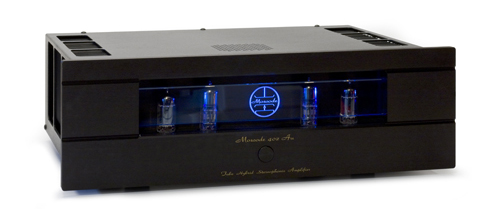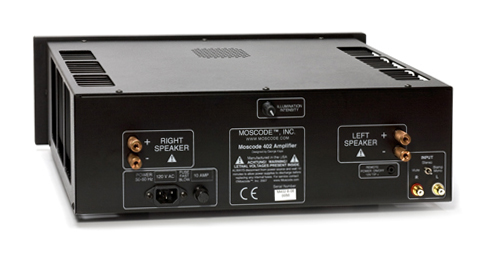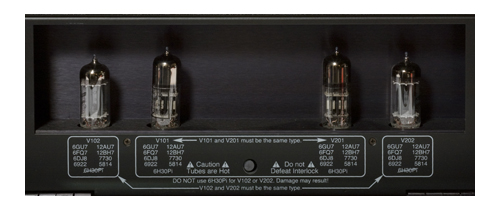Moscode 402au It's The Best of Both Worlds
By Jeff DorgayThe question of whether to power your HiFi system with tubes or transistors has plagued audiophiles for years, with each camp having valid reasons why which is better, but in the end we love what we respond to most strongly; measurements and specs be damned. Up until I found peace and happiness with an all solid-state system from Burmester, I’ve always enjoyed the combination of a tube preamplifier and solid-state power amplifier for years. It started in 1981 when I mated my Threshold 400A power amplifier to a Conrad Johnson PV-2a.
However, to flash forward, hybrid power amplifiers that usually combine a tube driver stage with a solid-state output stage have always been somewhat rare but usually very special products indeed. One of the most special is the Moscode 402AU that we have here for review. Moscode designer George Kaye doesn’t have just any hybrid; he was the first to develop a tube input/MOSFET output stage amplifier, the legendary New York Audio Labs Moscode 300. It was a great amp for the day, but was ultimately limited by the generic quality of parts used at the time that are upgradeable today. As designer George Kaye said, “That was my state of the art at the time. It took 20 more years to refine the Moscode to todays level.”
Today, the 402AU is not hampered by the “cloudiness” that used to plague MOSFET amplifiers of all kinds. The circuitry is up to date and this amplifier features a big, beefy power supply to go along with some other innovative features. This $6,495 power amplifier puts out a very healthy 200 watts per channel into 8 ohms in a dual mono design. As you remove it from its shipping carton, you can feel the quality inside.
Popping the top panel reveals a massive power supply, gold plated circuit boards, (hence the AU in the model designation) and careful attention to detail everywhere you look. It’s obvious that a lot of care was taken in building these amplifiers.
Available in brushed silver, or a black anodized finish (the color of my test sample), the 402 AU has a clear, etched glass front plate with the Moscode logo that glows soft blue along with the four driver tubes, right up there where you can see the glow. Pushing the center mounted power switch on the front panel starts the blue glow blinking for about two minutes until the amplifier is ready to operate, with the outputs staying muted.
Though it sounds good right from startup, once broken in the Moscode takes about 45 minutes to open up all the way, but it’s worth the wait! And for those of you that need to listen in absolute darkness, you can shut the front panel lights off, but I think it’s way too cool to do so…
Straightforward setup
The rear panel is basic and to the point, with Cardas RCA jacks and Edison Price speaker binding posts. Hats off to George Kaye for including these high quality binding posts that accommodate spade or banana ends, instead of those dreadful plastic coated binding posts that many manufacturers are going to. Hooking up my reference Shunyata Stratos SP speaker cables (that are a bit on the bulky side) was a snap.
During the initial 100 hours I spent on burning the 402AU in, I used the supplied, basic power cord to get a baseline read on the sound. Once that was established, I switched to a Shunyata Anaconda cord that powers everything else in my system, so I could make a valid comparison to other components in my system. While it certainly will perform well with the stock power cord, I highly suggest a premium power cord with any high current, high power amplifier to get 100% of what it is capable of. For the review period, the Moscode had a dedicated 20amp line all to itself.
While the Moscode has a pair of single ended RCA inputs, I had excellent success with both single ended and balanced (with XLR adaptors) preamplifiers. I made it a point to use the Moscode with everything from my vintage Audio Research SP-9 all the way up to the Burmester 011. It worked well in every situation I auditioned it and was not particularly swayed by different choices of interconnects either. It had enough resolution that I could easily tell the differences between whatever cable I was using, but nothing in my arsenal from Shunyata, Cardas, Furutech or the others wouldn’t work. The Moscode gets high points for being a great chameleon and not having any system synergy issues.
I had the same luck with speakers. As is customary here, I like to try any power amplifier in question with at least five or six speakers that vary greatly in efficiency as well as difficulty to drive. My Magnepan 1.6’s and MartinLogan CLX’s are both very revealing speakers at their respective price points, yet can be somewhat difficult to mate with an amplifier. Again, the Moscode did a great job with both speakers and would be an amplifier I would suggest wholeheartedly should you own either of these speakers. Having just finished two issues almost completely full of speaker reviews, I went beyond the normal call of duty and probably auditioned the Moscode with about 20 different speakers.
It’s safe to say that this is an amplifier you can live with for a very long time and should not have to trade in if your taste in speakers should change down the road. And if you need more juice, you can operate the amplifier in BiAmp mode, which parallels the inputs for two channels of equal power, one for the highs and one for the lows, however I had no trouble driving my reference speakers with just one amplifier.
Glorious sound
When I earned my living as a commercial photographer and had to go to numerous press checks, when my work was being printed, the age-old argument over “correct color” and “pleasing color” always came up. I have always preferred the printed page to be slightly shifted towards the red, warmer side than the blue, colder side and I like audio the same way. Sure, if we can achieve that perfect balance, that would be ideal, but I’ll take a slight dose of tonal richness over sterility any day of the week.
However, it’s tough to just get that ever so slight drop of “tubiness” into the mixture without spoiling it and coming up with a sound that is colored, gooey and rolled off. It only takes a few percent of magenta or cyan to ruin yellow and here Kaye has succeeded brilliantly. Everything I listened to during the review period had the slightest bit of tonal richness that I enjoyed tremendously. Drum heads sounded very life-like and stringed instruments had a realism that is rarely heard in an amplifier at this price point.
Where a tube power amplifier usually goes too far for my taste, (especially at this price point) and ends up getting a little whumpy in the bass department, the Moscode keeps it tight. Probably has a little bit to do with George Kaye being a bass player… Acoustic instruments had an extra dose of palpability thanks in part to the tubes up front. It’s hard to get around em. And the female vocal lovers in the group will really love this amp too. This is one that lets you get lost in the performance.
Two things really stood out with the Moscode. It’s ability to throw an incredibly deep soundstage and the amount of low-level detail it possessed. I spent a lot of time listening with the Harbeth Monitor 40.1’s and these speakers will not reveal front to back detail with a mediocre amplifier. When listening to the latest MoFi CD release of Beck’s Sea Change, I had stuff spinning all over the room as if I had a pair of surround speakers. Very cool.
Live recordings are always fun to listen for hall ambience to place the players in a distinct acoustic space and my favorite test record of late is Classic Records’ remaster of Neil Young’s Live at Massey Hall. If you’ve had the pleasure to listen to this on a great system, you know how big this record sounds. But another favorite of mine is Jacqui Naylor’s’ Birdland: Yoshi’s East/West. You can hear the depth in the audience on this one. When the people are clapping and clinking their glasses, you can hear the depth in how close or far away from the stage as well. A lesser amp just puts the claps up on the same plane with the stage. Just another day as a HiFi nerd, but something that jumped right out at me when listening to the Moscode.
All this talk about detail and tonality is somewhat meaningless without grunt. Grunt is the fourth dimension in my book. The Moscode possesses a lot of grunt without giving up finesse and that’s what makes it such a special amp. Whether you are listening to a full symphony or blazing guitars loud, the Moscode doesn’t lose its fine-grained ability to pluck the details out of the mix. This amplifier passes the ultimate test – after about 20 minutes you are under it’s spell and you’ll find yourself wanting to just keep spinning whatever kind of discs are in your collection. Unless you have very inefficient speakers, I can’t imagine needing more than one of these amplifiers.
One last trick
For those of you that can’t leave well enough alone, the front panel of the Moscode flips down and exposes the tubes. The 402AU comes from the factory with a pair of 6H30 tubes in the V101 and 201 positions and a pair of 6GU7’s in the V102 and 202 positions. As long as you replace them in identical pairs, you can tube roll to your hearts content. I must warn you though, if you lean the least bit towards adult ADD, this could be the ball of catnip that keeps you from enjoying the music, so don’t say I didn’t warn you. While I did not do a ton of tube rolling (because I really liked the sound straight from the factory) I did swap the factory 6H30’s for a pair of NOS 6H30’s that used to reside in one of my BAT preamplifiers and this is definitely a worthwhile upgrade. The 6H30 tube is very powerful and robust but can be slightly harsh. The older versions of this tube have all the power and less grain. A good pair of these will set you back about $4-500, but they do take the Moscode to an even higher level of inner detail without any harshness.
Interestingly, you can use 6922/6DJ8 tubes in all four positions, but you can only use the 6H30’s in the inside two sockets. This added flexibility assures that you should be able to get tubes for the 402AU no matter where you are.
33 1/3 days to make up your mind
Another part of the Moscode’s secret charm is that it’s sold factory direct. If this amplifier were sold through the traditional dealer network, it would probably cost about 33 1/3 % more. Though I normally am on the side of the traditional retail channel, smaller manufacturers selling direct evens out the playing field and allows them to be more competitive. Best of all, you have 33 1/3 days to return it (in the condition you received it of course) should it not be for you, but I’m guessing this is one you’d have a hard time to walk away from. Don’t have them send you one if you aren’t ready to write the check. George Kaye did mention that they have started selling the 402AU through select dealers, and the pricing will stay the same.
If you need a high-powered amplifier that sounds wonderful and is not the least bit fussy, I can’t suggest a better choice than the Moscode 402AU. I love this amp and purchased the review sample for permanent duty as a reference component here in the TONE studio. I’ve heard many an audiophile and audio critic discuss where the “point of diminishing returns truly is” and this is and amplifier that you will have to spend quite a bit more money to get this combination of power, resolution and musicality.
Manufacturers Information
Moscode
74 Cotton Mill Hill, Suite A124
Brattleboro, VT 05301
1-877-797-8823
www.moscode.com
Peripherals
Preamplifiers C-J ACT2/series 2, Burmester 011, ARC SP-9 and SP-17, Nagra PLL, Red Wine Audio Isabella, BAT VK-32SE, McIntosh MC2300
Digital Sources Naim CD555, Wadia 781SE, Sooloos Music Server
Analog Sources Spiral Groove SG-2 w/Triplanar and Dynavector XV-1s, Nagra VPS phono stage with VFS platform
Speakers MartinLogan CLX, Magnepan 1.6, Harbeth Monitor 40.1, Verity Audio Sarastro II, GamuT S-7, Zu Audio Essence
Cable Shunyata Anaconda power cords, Shunyata Stratos SP speaker cables, Shunyata Aurora interconnects
Power Running Springs Jaco and Dmitri Power conditioners



